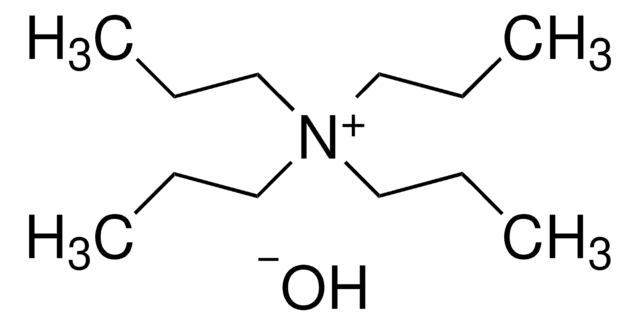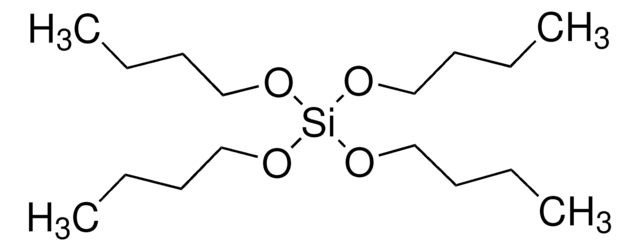333859
Orthosilicate de tétraéthyle
99.999% trace metals basis
Synonyme(s) :
Ester tétraéthylique de l'acide orthosilicique, TEOS, Tétraéthoxysilane
About This Item
Produits recommandés
Densité de vapeur
7.2 (vs air)
Niveau de qualité
Pression de vapeur
<1 mmHg ( 20 °C)
Pureté
99.999% trace metals basis
Forme
liquid
Indice de réfraction
n20/D 1.382 (lit.)
Point d'ébullition
168 °C (lit.)
Densité
0.933 g/mL at 20 °C (lit.)
Chaîne SMILES
CCO[Si](OCC)(OCC)OCC
InChI
1S/C8H20O4Si/c1-5-9-13(10-6-2,11-7-3)12-8-4/h5-8H2,1-4H3
Clé InChI
BOTDANWDWHJENH-UHFFFAOYSA-N
Vous recherchez des produits similaires ? Visite Guide de comparaison des produits
Description générale
Application
Mention d'avertissement
Warning
Mentions de danger
Conseils de prudence
Classification des risques
Acute Tox. 4 Inhalation - Eye Irrit. 2 - Flam. Liq. 3 - STOT SE 3
Organes cibles
Respiratory system
Code de la classe de stockage
3 - Flammable liquids
Classe de danger pour l'eau (WGK)
WGK 1
Point d'éclair (°F)
113.0 °F - closed cup
Point d'éclair (°C)
45 °C - closed cup
Équipement de protection individuelle
Eyeshields, Faceshields, Gloves, type ABEK (EN14387) respirator filter
Faites votre choix parmi les versions les plus récentes :
Déjà en possession de ce produit ?
Retrouvez la documentation relative aux produits que vous avez récemment achetés dans la Bibliothèque de documents.
Les clients ont également consulté
Articles
From Form to Function: Molding Porous Materials in Three Dimensions by Colloidal Crystal Templating
Research involving reactive silicone chemistry has focused on the production of pure silicon and hybrid materials, hydrosilylation, ring-opening and atom transfer polymerizations, polymerizations with controlled stereochemistry, and condensation reactions.
Mesoporous Oxides and Their Applications to Hydrogen Storage
Recent demand for electric and hybrid vehicles, coupled with a reduction in prices, has caused lithium-ion batteries (LIBs) to become an increasingly popular form of rechargeable battery technology.
Notre équipe de scientifiques dispose d'une expérience dans tous les secteurs de la recherche, notamment en sciences de la vie, science des matériaux, synthèse chimique, chromatographie, analyse et dans de nombreux autres domaines..
Contacter notre Service technique














